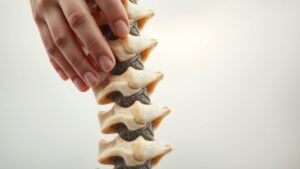Envision your spine as a sturdy tower, but over time, wear and tear can chip away at its foundation. As you approach your forties, you may notice some changes that feel all too familiar—aches, stiffness, or even a twinge of discomfort after a long day. What happens when I tell you that there are specific causes behind this spinal degeneration, and simple care solutions could help you regain strength and mobility? Allow us to investigate how lifestyle choices play a significant role in your spinal health.
Spinal Degeneration
As you age, it’s natural for your body to go through changes, and one of those changes can be spinal degeneration.
This condition, often called degenerative disc disease, occurs at the time the discs between your vertebrae lose elasticity and dry out, usually starting around age 40.
You may notice symptoms like back pain, neck pain, or discomfort radiating to your arms or legs, especially at the time of sitting or lifting.
Diagnosis often involves a physical exam and imaging tests to assess disk degeneration.
Fortunately, there are various treatment options available. Physical therapy can help strengthen your back and improve mobility.
Comprehending spinal degeneration is essential, as confronting these symptoms promptly can lead to more effective care and a better quality of life.
Causes of Spinal Degeneration
Spinal degeneration, a common concern for many people, often sneaks up on individuals. Aging is the primary culprit, with nearly 90% of folks showing signs during age 60 due to the natural drying out of spinal disks and loss of elasticity.
Should you be facing obesity, the extra weight can exert more stress on your spine, making degeneration more likely.
Repetitive strain from physically demanding jobs can lead to significant wear and tear on spinal structures.
Don’t forget genetics: a family history of spinal issues means you’re at higher risk.
And should you smoke, be aware that it reduces blood flow to your spinal disks, worsening degeneration.
Taking these factors into account can help you better understand your spine health.
Symptoms of Spinal Degeneration
Should you experience neck or back pain, it’s crucial to recognize that this discomfort could signal spinal degeneration, a condition many individuals face as they age.
You could notice intermittent pain that worsens during physical activities, especially while sitting, bending, or lifting. This can lead to acute discomfort in the lumbar spine and could even radiate into your arms, legs, or buttocks.
Symptoms of degenerative disc can also include nerve compression, which results in numbness and tingling along with weakness in your extremities.
As you maneuver through daily life, you may find sitting discomfort increasingly frustrating.
Should your symptoms persist, it’s vital to seek medical evaluation to address your pain and prevent further complications.
Diagnosis of Spinal Degeneration
Whenever you suspect spinal degeneration, obtaining the right diagnosis is essential to effective care.
Your doctor will begin by asking about your medical history and symptoms, then conduct a physical examination to assess your nerve function and muscle strength.
Imaging tests like MRIs or CT scans will also play a vital role in visualizing any disc damage and ensuring a clear treatment path.
Physical Examination Techniques
A thorough physical examination is your initial step toward comprehending spinal degeneration and finding relief.
It usually starts with a detailed discussion of your medical history, including symptom onset and factors that could worsen your pain. Your doctor will assess your spine’s range of motion and check for signs of nerve compression, such as weakness or numbness.
They may also palpate your spine to identify areas of tenderness or muscle spasms. Strength tests will determine whether there’s any muscle weakness tied to spinal nerve issues caused by disk degeneration.
While a physical examination provides significant understanding, diagnostic imaging, like X-rays or MRI, can further illuminate your spinal condition. This collaborative approach aids in creating an effective treatment plan.
Imaging Test Options
After grasping the significance of a thorough physical examination, it’s now time to investigate how imaging tests can provide a clearer depiction of spinal degeneration.
Imaging tests are essential in diagnosing conditions, with MRI being the go-to for revealing soft tissue issues like disc herniation and nerve compression. Initially, your doctor may order X-rays to observe vertebral alignment and any bone spurs.
Should more detail be needed, CT scans come into play, showcasing bony abnormalities. Myelography involves a contrast dye to improve these images, allowing for better visualization of nerve root compressions.
This combination of imaging tests and clinical evaluations enables your healthcare provider to devise effective treatment plans customized just for you.
Treatment Options for Spinal Degeneration
At the point of treating spinal degeneration, you’ve got a range of options to evaluate.
Non-surgical remedies like physical therapy and lifestyle changes can make a significant difference in your daily comfort.
Should those not be sufficient, surgical interventions might offer lasting relief for more severe symptoms, so you can get back to enjoying life to the fullest.
Non-Surgical Remedies
Managing spinal degeneration can be challenging, but you don’t have to face it alone. There are effective non-surgical treatments to help alleviate your pain and improve your quality of life.
Integrating physical therapy can strengthen your back muscles while enhancing flexibility, making everyday activities easier. Simple lifestyle modifications, like maintaining a healthy weight and engaging in low-impact exercises such as walking or swimming, can reduce stress on your spine.
Don’t forget about heat and cold therapy; applying heat pads or ice packs can provide quick relief. Additionally, alternative treatments like acupuncture may help manage discomfort through promoting relaxation.
Keep in mind, you’re not stuck—exploring these options can help you regain control and feel better.
Surgical Interventions
Spinal degeneration can feel overwhelming, especially at times conservative treatments just don’t cut it anymore.
Should you be facing chronic pain or significant nerve compression, surgical interventions could be the solution. Here are a few options to contemplate:
- Discectomy: Removes herniated disc material to relieve nerve pressure.
- Spinal Fusion: Stabilizes the spine by permanently joining vertebrae.
- Laminectomy: Relieves nerve pressure by removing part of a vertebra.
These procedures often lead to significant pain relief and better mobility.
Post-surgery, a multidisciplinary approach including physical therapy is essential for maintaining spinal health and enhancing recovery results.
Keep in mind, you aren’t alone in this; many have successfully walked this path and found relief.
Lifestyle Modifications
Though it may feel intimidating at times, making simple lifestyle changes can have a significant impact on spinal degeneration. Through focusing on a few key modifications, you can boost your spinal health and alleviate pain. Check out the table below for more tips!
| Lifestyle Modification | Benefits |
|---|---|
| Maintain a healthy weight | Reduces stress on the spine |
| Regular low-impact exercises | Improves flexibility and strength |
| Good posture | Reduces strain on spinal discs |
| Physical therapy | Focuses on core strengthening |
| Quit smoking | Improves blood flow to discs |
Making these adjustments can slow down degenerative changes, improve spine function, and contribute to a more active, pain-free life. Take small steps; your spine will thank you!
Prevention Strategies for Spinal Degeneration
As it pertains to keeping your spine healthy, you’re far from alone in seeking ways to prevent degeneration. Here are some effective strategies you can easily implement:
- Maintain a healthy weight to lessen strain on your spine.
- Engage in low-impact exercises like swimming or walking to strengthen back muscles and improve spinal flexibility.
- Practice good posture during daily activities to reduce unnecessary stress on your spine.
Don’t forget about stretching routines! Regularly stretching helps boost mobility and relieve tension in your spinal structures.
Also, steer clear of smoking; it harms blood flow, hindering healing, and raises your risk of degeneration.
Through following these strategies, you’ll support your spinal health and keep your back feeling great!





